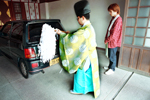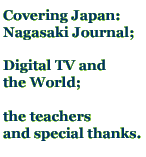 |
Covering
Japan: Nagasaki Journal |
The Students
Click the highlighted text within a story description to read the full story. |
society |
Austin Ramzy writes in the San Jose Mercury News about the struggle for students between kindergartens and day care centers. And Jessi Hempel's San Jose Mercury News story looks at the increasing number of students refusing to go to school out of boredom, pressure to conform or fear of teachers and students. |
work 
|
Carole-Anne Elliott's main San Jose Mercury News story explores the effects of a decade of recession on older workers. Her sidebar introduces an older worker who switched gears in time to find new work as a "home helper." And Jessi Hempel's San Jose Mercury News piece follows an environmental activist who fights to continue the work of her late husband. |
culture  |
Bruce Gerstman's San Jose Mercury News story looks at the Suwa Shrine, where Japanese go to ask for blessings on their cars and even ways to end their love affairs. And Austin Ramzy's San Jose Mercury News story takes us back in time to Nagasaki's Dejima island, now being reconstructed as a tourist attraction. |
survival 
|
Chris O'Connell's washingtonpost.com video explores how the World War II atomic bomb attack on Nagasaki still affects survivors, nearly 57 years later. |
This site was created by Carole-Anne Elliott, who received her master's degree
from the Graduate School of Journalism in May, 2003.

